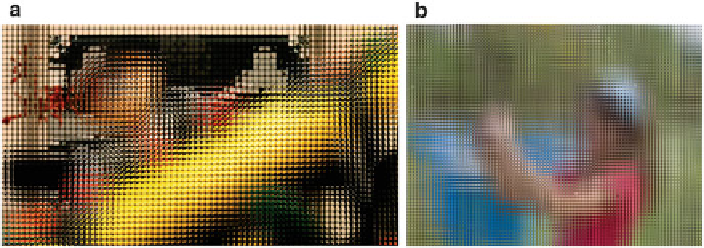Image Processing Reference
In-Depth Information
position in the reference picture list. This index is conveyed along with the
prediction information of Inter prediction modes and transmitted to identify, at
the decoder side, the position of the used reference picture.
5.5 Performance Evaluation
This section illustrates the Rate Distortion (RD) performance of the 3D holoscopic
coding solution described in this chapter. This performance is evaluated in two
different sections:
• Section
5.1
presents a RD comparison between coding schemes based on the
different representation formats of the 3D holoscopic content. As it was
discussed in this chapter (Sect.
5.3
), there are various possible representation
formats for the 3D holoscopic content which present intrinsic correlations that
are likely to be exploited to improve the coding efficiency. Therefore, a com-
parative analysis of the self-similarity compensated prediction method applied
to different forms of representation of the 3D holoscopic content is presented.
Notice that, in these coding schemes the 3D holoscopic content is encoded
independently of the lower layers (
Base Layer
and
First Enhancement Layer
)
in the presented scalable coding architecture. Therefore, it can be interpreted as a
comparison between possible simulcast coding solutions;
• Section
5.5.2
presents the RD performance of the described scalable coding
solution, where inter-layer and self-similarity compensated prediction are
combined.
Two different 3D holoscopic test images with different spatial resolutions were
used in these tests, as can be seen in Fig.
5.14
:
•
Plane and Toy
, with a resolution of 1920
1088 pixels; micro-image resolution
28 (Fig.
5.14a
);
•
Laura
, with a resolution of 7240
of 28
5432 pixels; micro-image resolution of
75
75 (Fig.
5.14b
; available in [
28
]).
Fig. 5.14 3D holoscopic test images: (a) Plane and Toy; and (b) Laura

